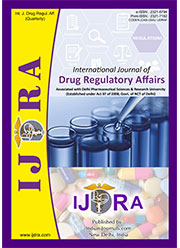FORMULATION DEVELOPMENT AND IN VITRO EVALUATION OF FLOATING TABLETS OF LAFUTIDINE BY EMPLOYING EFFERVESCENT TECHNOLOGY
Abstract
In the present research work gastro retentive floating matrix formulation of Lafutidine by using various polymers were developed. Initially analytical method development was done for the drug molecule. Absorption maxima was determined based on that calibration curve was developed by using different concentrations. Gas generating agent sodium bicarbonate concentration was optimised. Then the formulation was developed by using different concentrations of polymers Xanthan gum, guar gum and Sodium Alginate as polymeric substances. The formulation blend was subjected to various pre-formulation studies, flow properties and all the formulations were found to be good indicating that the powder blend has good flow properties. Among all the formulations Only Xanthan gum, Sodium Alginate highest concentrations (60 mg) retards the drug release upto 12 hours and the drug release 96.25%, 95.81% respectively. In this Xanthan gum releases the more drug release when compared to Sodium alginate. So F3 Formulation considered as optimised formulation. Optimised formulation F3 was kept for release kinetic studies. From the above graphs it was evident that the formulation F3 was followed the Peppas release mechanism.
Downloads
References
2. Robinson jr, Lee v.h.l. controlled drug delivery: Fundamentals and applications. 2nd edn. New York: Marcel dekker; 1978 .p.24-36.
3. Brahmankar D.M, Jaiswal S B. Biopharmaceutics and pharmacokinetics a treatise. 1st ed. New Delhi: Vallabh prakashan; 1995 .p.64-70.
4. Chein YW. Novel drug delivery systems. 2nd ed. New York: Marcel Dekker; 1992 .p.4-56.
5. Ansel. Pharmaceutical dosage form and drug delivery system. 7th ed. Lipincott; .p. 553.
6. Gennaro R.A. Remington,the science and practice of pharmacy. 20th ed. New York: Lippincott Williams; 2000 .p.1045.
7. Banker G.S, Rhodes C.T. Modern pharmaceutics. 3rd ed. New York: Marcel Dekker; 1996 .p.678-721.
8. Vyas S.P, Khar R.K. Controlled drug delivery: concepts and advances. 1st ed. New Delhi: Vallabh prakashan; 2002 .p.345-76.
9. Shweta Arora. Floating drug delivery: a review. AAPS Pharmscitech; 2005; 47(11):268-72.
10. Libo Yang. A new intragastric delivery system for the treatment of H.pylori associated with gastric ulcers, elsevier j. Of controlled release. Apr. 1999; 34 (5): 215-22.
11. Ross and Wilson. Anatomy physiology and health education. 9th ed. Churchil Livingston;, 295-311.
12. Wilson K.R.W. Waugh A. Anatomy and physiology in health and illness. 9th ed. London: Churchill Livingstone; 1996 .p. 342-45.
13. Garima Chawla. A means to address regional variability in intestinal drug absorption: Pharmtech;. 2003 .p.234-38.
14. Chawla G, Gupta P, Koradia V, Bansal A. Gastroretention: A means to address regional variability in intestinal drug absorption. Pharm. Tech; 2003 .p.50-68.
15. Desai S, Bolton S. A floating controlled release system: in-vitro and in-vivo evaluation. J. Pharm. Res. 1993; 10:1321-25.
16. Garg S, Sharma S. Gastroretentive drug delivery systems. Pharmatech; 2003 .p.160-64.
17. Dr.Jose, Khalid Shah. Gastroretentive drug delivery system, business brief. Pharmtech; 2003 .p. 165-73.
18. Deshpande A.A, Shah N.H, Rhodes C.T, Development of a novel controlled release system for gastric retention. J. Pharm. Res. 1997; 14(6):815-819.
19. Garima Chawla. A means to address regional variability in intestinal drug absorption. Pharmtech; 2003 .p.234-38.
20. David S.S. The effect of density on the gastric emptying on single and multiple unit dosage forms. J. Pharm res. 1986; 3:208-13.
21. H.G. Sivakumar, floating drug delivery system for prolonged gastric residence time: a review, ind. J. Pharm. Edu., oct-dec-2004 p.311-316.
22. Singh B.N., Kim H. Floating drug delivery system an approach to control drug delivery via gastric retention. J. Controlled release. 2000; 63(7): 235-59.
23. Choi B.Y., Park H.J. Preparation of alginate beads for floating drug delivery system: effect of CO2 gas forming agent. J. Contolled release. 2000: 25(6):488-91.
24. Ingani H.M, Timmermans J, Moes A.J. Concept and in-vivo investigation of peroral sustained release floating dosage forms with enhanced gastrointestinal transit. Int. J. Pharm. 1987; 35:157-64.
25. Bhavana V, Khopade A.J, Jain W.D, Shelly and Jain N.K. Targeted oral drug delivery. Indian Drugs. 1996; 33:365-73.
26. Roop K. Khar. Controlled drug delivery. Gastroretentive System. 4th edn. p. 202-3
27. Hradman J.G, Limbrid. Goodman Gilman’s, The pharmacological basis of therapeutics. 10th edn, New York: 2001 .p. 1765.
28. Ichikawa M, Watanabe S, Miyake Y. A New Multiple-unit oral floating dosage system: preparation and in-vitro evaluation of floating and sustained-release characteristics. J. Pharm. Sci. 1991; 80:1062-66.
29. Abubakr O. Nur and Jun S. Zhang. Captopril floating and/or bioadhesive tablets: design and release kinetics. Taylor & Francis. 2000;26(9):965-69.
30. Menon A, Wolfgang A.R, Saks A. Development and evaluation of a monolithic floating dosage form for furosemide. J. Pharm. Sci. 1994; (83): p. 239-245.
31. Wie J.P, Huang. Preparation of the 5-fluoro uracil floating sustain release tablets for gastric retention. Beijing: Da Xue Xue Bao; 2004;36(4):493-42.
32. Streubel A, Siepmann J, Bodmeier R. Floating matrix tablets based on low density foam powder: effects of formulation and processing parameters on drug release. Eur. J. Pharm. Sci. 2003; (18): p.37-45.

This work is licensed under a Creative Commons Attribution-NonCommercial 4.0 International License.
The International Journal of Drug Regulatory affairs require a formal written transfer of copyright from the author(s) for each article published. We therefore ask you to complete and return this form, retaining a copy for your records. Your cooperation is essential and appreciated. Any delay will result in a delay in publication.
I/we have read and agree with the terms and conditions stated Page 2 of this agreement and I/we hereby confirm the transfer of all copyrights in and relating to the above-named manuscript, in all forms and media, now or hereafter known, to the International Journal of Drug Regulatory affairs, effective from the date stated below. I/we acknowledge that the IJDRA is relying on this agreement in publishing the above-named manuscript. However, this agreement will be null and void if the manuscript is not published in the IJDRA.
Download link for COPYRIGHT FORM







